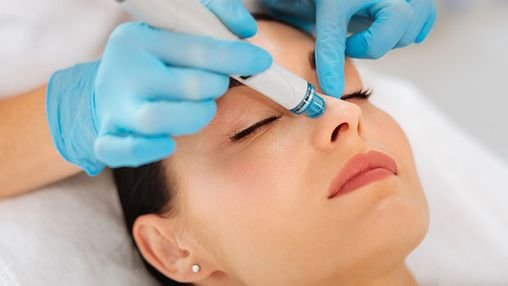The Hydrafacial isn’t just another spa trend—it’s a science-backed skincare treatment taking over clinics from Los Angeles to New York City. Beauty editors, dermatologists, and influencers alike call it the “facial of the future” because it delivers visible results after just one session.
Unlike traditional facials that rely on manual extraction or harsh peels, the Hydrafacial device uses patented vortex-fusion technology to clean pores and infuse skin with serums. This blend of hydration, exfoliation, and antioxidant infusion is what makes experts believe it might truly be the only treatment your skin ever needs.
Read also: Could Foenegriek Be the Missing Link Between Traditional Remedies and Modern Nutrition?
Understanding What a Hydrafacial Really Does
How the Hydrafacial Process Works Step-by-Step
A Hydrafacial works in three simple yet powerful stages:
- Cleanse and Peel – The skin is gently exfoliated to remove dead cells.
- Extract and Hydrate – Impurities and blackheads are vacuumed out while serums rich in hyaluronic acid, peptides, and antioxidants are infused.
- Fuse and Protect – The skin receives a final dose of nourishing ingredients to lock in moisture.
This multi-step process doesn’t just improve skin texture—it resets your skin barrier, leaving your complexion refreshed and glowing.
The Science Behind Hydration and Exfoliation
According to American Academy of Dermatology (AAD) experts, hydration plays a critical role in maintaining elasticity and preventing premature wrinkles. The Hydrafacial uses medical-grade serums designed to bind moisture to skin cells, improving suppleness.
Exfoliation, meanwhile, triggers mild cell turnover, helping your skin absorb nutrients better. The result? Skin that looks smoother, plumper, and younger without irritation or downtime.
Why It’s Popular Among Dermatologists
Renowned dermatologists like Dr. Ava Shamban and Dr. Whitney Bowe emphasize that Hydrafacial treatments are gentle enough for sensitive skin but powerful enough to target acne, hyperpigmentation, and fine lines. Unlike microdermabrasion or chemical peels, it suits nearly every skin type—making it a universal favorite in cosmetic dermatology.
Common Problems People Face Before Trying a Hydrafacial
Dehydrated or Dull Skin Issues
Environmental stress, makeup, and pollution can deplete your skin’s natural glow. The Hydrafacial replenishes lost hydration using antioxidant-rich serums, restoring that “lit-from-within” look.
Stubborn Blackheads and Congestion
Clogged pores are among the most persistent skincare challenges. Unlike harsh extractions, the Hydrafacial’s vortex suction clears buildup without redness or irritation—ideal for people prone to breakouts or enlarged pores.
Overpromised Results from Generic Facials
Many facials offer short-term shine but no real improvement. What sets the Hydrafacial apart is its clinical consistency—results are measurable, repeatable, and build with time.
Real Results — When a Hydrafacial Is Worth It
Short-Term Glow vs. Long-Term Benefits
Most users notice brighter skin immediately after their first session. However, experts at Cleveland Clinic note that long-term benefits—like even tone and reduced fine lines—come after consistent sessions spaced 4–6 weeks apart.
Ideal Candidates for Maximum Results
Anyone experiencing dryness, sun damage, acne scars, or aging signs can benefit. Hydrafacial technology adjusts its serum levels and suction strength, making it adaptable to all skin types, from oily to sensitive.
When You Should Skip It and Save Money
Those with active rosacea, open wounds, or certain skin infections should wait until conditions improve. Dermatologists also advise skipping if you’re using Retin-A or undergoing Accutane therapy.
Cost vs. Value — Breaking Down the Investment
| Treatment Type | Average Cost (USD) | Duration | Key Benefit |
|---|---|---|---|
| Hydrafacial | $150–$300 per session | 30–45 mins | Deep cleansing + hydration |
| Regular Facial | $60–$100 | 45–60 mins | Basic cleansing |
| Microneedling | $250–$400 | 45 mins | Collagen stimulation |
Is It Worth the Price Tag?
Most experts agree that Hydrafacial treatments justify their cost due to instant results and minimal downtime. Compared to repetitive over-the-counter products, this one-time investment often yields stronger outcomes for texture, tone, and elasticity.
Comparing Hydrafacial to Traditional Facials
Traditional facials often use manual techniques that can cause redness or uneven results. In contrast, the Hydrafacial system offers precision control and serum customization, giving both short-term glow and long-term renewal.
Expert Tips to Make Your Hydrafacial Worth the Money
Pre-Treatment Prep for Best Results
- Avoid retinol, AHAs, and BHAs 48 hours before.
- Stay hydrated—drink plenty of water for maximum serum absorption.
- Skip makeup on treatment day to prevent clogged pores.
Post-Treatment Care and Maintenance
- Use gentle cleansers and SPF 30+ daily.
- Avoid harsh exfoliation or steam rooms for 24 hours.
- Apply serums rich in niacinamide and vitamin C to maintain brightness.
How Often Should You Get It Done?
Dermatologists recommend one Hydrafacial per month for ongoing results. Over time, it improves collagen production and reduces the need for other treatments, making it a cost-effective long-term skincare strategy.
Conclusion — A Future-Proof Skincare Investment
The Hydrafacial isn’t just another passing beauty trend—it’s a proven, noninvasive method that blends medical science with luxury skincare. Experts agree it offers visible, long-lasting results for almost every skin type, without the downtime or discomfort of harsher treatments.
Whether you’re chasing that post-facial glow or aiming to correct deeper skin issues, the Hydrafacial bridges both worlds—instantly and effectively. For many, it truly might be the only skincare treatment you’ll ever need.

